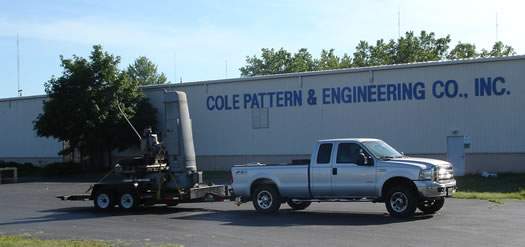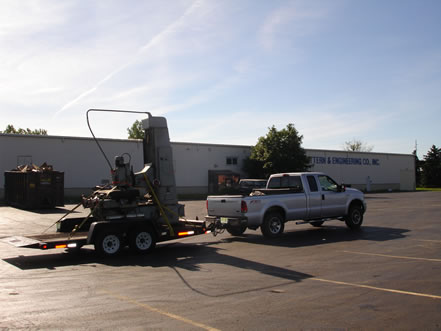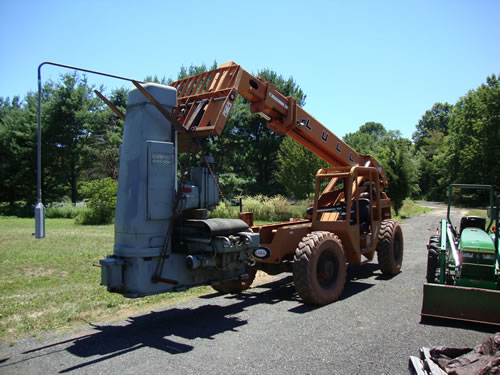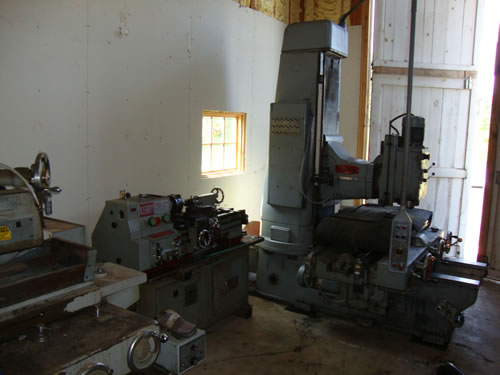On June 21st, 2010, Maynards hosted the on-line liquidation of Cole Pattern & Engineering in Fort Wayne, Indiana.

This is another sale that I stumbled upon while searching for Wadkin parts. The only item I was interested in was a Wadkin WL 20 vertical milling machine. This mill is much bigger and heavier than any machine I’ve owned. It has a gross weight of 14,450 LBS, and is just under 11′ tall. I’ve recently run up against the limitations of my Toolmaster mills. In particular, the throat capacity and the longitudinal movement have both come up short on a few projects I have waiting. The WL 20 has an impressive throat capacity of 35″. It also has a longitudinal movement of 48″ and a transverse movement of 31″. A few other great features of the mill are the 360 degree power rotary table and the 300 degree swivel on the column.
There was a very generic description (“Wadkins Vertical mill 26″ x 48″ table and DRO”) and a single photo of the mill in auction catalog.

I couldn’t get to Fort Wayne for the preview, so I tried calling the auction company to get confirmation on the model/serial numbers of the machine. I reached the on-site handler, but he didn’t have phone service inside the building. He agreed to look at mill and call me back the next morning. The call never came and I was pretty nervous about whether I’d be able to get the mill out of the building and then trailer it the 600 miles back to Jersey. I decided to drop a $350 bid on it and do a wait and see on the rigging and transportation. The worse case scenario is that I’d strip the DRO and tooling from the machine and sell the hulk to the local scrap dealer.
As it turned out, my $350.00 was the only bid. I now had to turn my attention to figuring out whether it was even possible for me to get the mill rigged out, loaded and trailered home. My bigest concern was the weight. My trailer is only good for 10,000 lbs. This mill obviously weighed all of that if not substantially more. To make matters worse, the removal period was five days. This meant I’d have to take a few days off work. I called the auction house several more times, but wasn’t able to reach anyone on-site. I did some on-line searches for documentation on this mill and started comparing pictures in an attempt to verify the model number. After all of this, all I could confirm was that I had a WL.
Two days before the final removal date, I decided to make the drive to Fort Wayne. I left Central Jersey at 4:00 AM and arrived at 2:00 in the afternoon. Most of the smaller machines in the sale had already been removed. There were a number of very large mills, CnC lathes and other miscellaneous machines still in the building. There was alot of activity around collecting the aluminum, steel and brass scrap. So much so that I had a difficult time finding anybody that would even discuss the removal.
When I finally located my mill, I was surprised to find a folder with all the documentation for the mill sitting right on the table. The first thing I did was open to the specifications page. The net weight was listed at 12,500 Lbs for the basic machine and 14,500 gross weight with all the options installed.
I found the on-site guy from Maynards and asked him about forklifts. He advised me that the only lifts available were rated for 5,000 Lbs or less. Given that I was only in town for the day, I decided to find the local scrap dealer. As it turned out, he was less than a mile away and agreed to come back to the plant to look at the mill. He agreed to buy it from me, but only if I could get it moved outside the building. Since none of the forklifts were big enough to remove the machine, I resigned myself to abandoning it. I started packing up the tooling and getting ready to strip the DRO and scales from the machine. About 30 minutes into the process, a forklift rental company truck pulled up and unloaded another forklift. After the driver left I went over and checked the lift out. It was small in size, but was rated for 33,000 Lbs.
It was almost 4:00 PM and everyone had left. I went and found the auction guy and asked him about the lift. He told me that one of the riggers had it delivered for a pickup the following week. I asked him what it would take for him to let me use the lift for an hour.
Auction Guy: Do you know how to run that lift?
“Absolutely.”
Auction Guy: Will that forklift pick that mill up?
“Absolutely.”
Auction Guy: OK. I’m going to dinner. The key’s in the lift… try not to break anything.
It took me less than 10 minutes to get the mill up on blocks and another 5 minutes to get it out into the parking lot. Once outside in the daylight it didn’t seem so big. I decided I should try setting it on the trailer and see how bad it looked. I had to move it around several times, but finally got it into a position where it looked like it would ride pretty well. I drove the truck around the parking lot a few times an was surprised by how well it was riding. I spent the next hour tying everything down and packing up the tooling.
By the time I finished, the auction guy showed up. I gave him fifty dollars and thanked him for his help.
Pulling out onto the highway, I could tell that this was a real load for my little truck. This wasn’t the heaviest load I had ever pulled, but it was the heaviest load I had ever pulled this far from home.
About 15 miles on my way, I stopped for fuel. After I got the pump going, I checked the trailer tires. The tires on the front axle were so hot I couldn’t hold my hand on them. At that point, I realized that I’d have to go alot slower (at least until the roads cooled down).
The trip home was gruelling. The worst of it was the hills along I-80 in western PA. I was slowing down to 35 MPH on every clim and speeding up to 70 going down the other side. I passed several open weigh stations along the way. I was surprised everytime that they didn’t come after me.
I finally arrived in Jersey the next morning at 10 AM. Happy to have made it home safe, I set my sights on getting the mill off the trailer. My Hyster is only rated for 5500 Lbs, so I had to go next door and get the Lull.
I rigged the mill with pipes through the base and used nylon straps over the top of the boom. The straps were rated for 12,000 Lbs, but one of them snapped as soon as I put pressure on them. I noticed that the front of the base had four large holes tapped on both sides. I remembered that my Wakin moulder had a set of lifting hooks bolted to it. Fortunately, they fit the mill. A few minutes later I had it rigged up with chains.

In order to position the boom over the base, I had to approach from the rear of the trailer and get the forks on either side of the column. With the mill positioned at the front of the trailer, this meant that the boom was extended about 10 feet. When I tried to lift the mill, the rear wheels of the Lull came off the ground. To get around this, I laid some heavy timbers on the deck of the trailer and retracted the boom. the mill slid back; turning the timbers to toothpicks on the way. Once it had moved back about four feet I was able to get it lifted off the trailer enough to drive out from under it.
Getting the mill into my building wasn’t as much of a hassle. I have a set of 14 foot wide doors at the back of the building. I was able to drive the lull directly inside and set the mill within eight feet of it’s final resting place. I used skates, wrecking bars and a railroad jack to get the mill positioned and set down on the leveling plates. The nice thing about this spot is that it is close enough to the door that I can use the forklift to put heavy workpieces on the table.
This mill will be a great addition to the shop. The first project I have queued up for it is a rolling table I had cast for an L. Power single end tenoner.
There were alot of other great machines in this sale:
This Tegle & Sonner jointer sold for $475._

This Martin planer sold for $3750._

This Kindt Collins 30″disc sander sold for $1100._

This DoAll metal bandsaw sold for $1025._

And this American 36″ Bandsaw sold for $150._

There were also several other milling machines that sold at reasonable prices:
Lagun Vertical mill With Anilam wizard 211 DRO $575._

Lagun Vertical mill With DRO Model# FTV25 $725._

Lagun Vertical mill With Sony DRO $600._

Ekstrom Vertical mill With DRO Model# 540 $250._

Bohner & Kohle With DRO Model# MFI $1900_

And finally, the machine I most regret not buying:
Veet Precision Radial Drill that sold for $250._

click here If you’re interested in seeing the complete results for the auction.
One thing I noted was that although many of the large machines were sold on-line, they were still up for grabs when I went for removal. Any of the CnC machines could have been had for scrap value after the auction. The scrap guy I spoke to was working a deal with the foundry to get most of the mills (large & small) and a bunch of the CnC machines.
The owwm
Tags: Auction, old woodworking machines, owwm, Pattern Making, Removal, Rigging, Wadkin, Wadkin Ltd, Wadkin Pattern Mill, Wadkin WL




















































































 I found this machine in an old cabinet shop in Brooklyn, New York. This saw was in perfect operating condition. I advertised it in the on-line forums for several months at $1000. I had no takers for the whole saw, but I got some offers on the feed chain, the kickback fingers and the fence. Once again, I stripped the saw and sent the remainder to the shredder. The saw brought $700 in scrap. The parts I sold brought another $1225.
I found this machine in an old cabinet shop in Brooklyn, New York. This saw was in perfect operating condition. I advertised it in the on-line forums for several months at $1000. I had no takers for the whole saw, but I got some offers on the feed chain, the kickback fingers and the fence. Once again, I stripped the saw and sent the remainder to the shredder. The saw brought $700 in scrap. The parts I sold brought another $1225.
Gorham-Lenox Egg Harbor City, New Jersey
Mar 14th, 2010 by The owwm
On December 5th, I attended the public auction of the Gorham Silver Factory in Egg Harbor City, New Jersey. The plant consisted of machinery and tools that had been consolidated into the New Jersey location as other plants were closed. The auction was hosted by Jay Sugarman Auctioneers out of Miami Florida. They were scheduled to sell the entire operation in one day. There was no woodworking machinery listed in the sale, but there were a number of Stanley Vidmar cabinets. I’ve been hoping to get some of these for awhile, so I figured it was worth the two hour trip to southeastern Jersey.
The plant consisted of machinery and tools that had been consolidated into the New Jersey location as other plants were closed. The auction was hosted by Jay Sugarman Auctioneers out of Miami Florida. They were scheduled to sell the entire operation in one day. There was no woodworking machinery listed in the sale, but there were a number of Stanley Vidmar cabinets. I’ve been hoping to get some of these for awhile, so I figured it was worth the two hour trip to southeastern Jersey.
The sale started with several hundred lots of miscellaneous tools. The pricing on these items was exceptionally good. I picked up a complete [SKF] bearing puller kit that was still shrink wrapped for $35. I also ended up with a urethane belt splicer for $15, a second bearing puller kit for $10, a box full of wheel/bearing pullers for $45, a pipe flaring kit for $15, a 5 ton toe jack for $25, a complete set of morse tapers for a milling machine (new in boxes) for $5, a needle scaler for $5, a very nice Starrett dial caliper for $15, an SK 3/4″ socket set with breaker bar for $25, and a few box lots of misc tools for $5 each. Next they moved on to selling a bunch of tool boxes, cabinets, and rolling carts. I ended buying eight RubberMaid rolling carts with toolboxes for $12 each.
Three hours into the sale and we were just getting to the maintenance department. This is where prices took a serious upturn. There were 30+ cabinets full of parts, hardware, etc. The auction brochure called for the contents to be sold separate of the cabinets. For whatever reason, the auctioneer decided to sell each cabinet with the contents as a single lot. About half of the cabinets were Stanley Vidmars:

Bidding on these cabinets was intense. Every one of them sold for between $600 and $1200. I ended up not buying a single one.
Next up was the machine shop. There were a few nice machines here, including a 26″ DoAll bandsaw with power feed table. The saw was in good condition and included a contour attachment. It sold for $550. There was also a very nice Cincinnati Tracer Mill:

This machine was exceptionally tight. It included two milling vises, two rotary tables, a cooling pump and a hydraulic power supply. The mill sold for $450.
I bought a very nice little 25 Ton Die Press for $125, two granite surface plates for $10 & $25, three two door shop benches/cabinets for $15 each, and all the dies for the press for $15. I also ended up buying two metal storage cabinets that were full of shop vac filter, scotch brite pads and sandpaper for $65.

The sale then moved outdoors to sell a loader, a telescopic boom manlift, and five dust collectors. It was snowing, so only about five people came outside. Once the loader and the manlift were sold, that number dwindled to three. I bid on the first dust collector and figured out pretty quickly that the scrap guy wanted it alot more than me. I didn’t bid on the remaining units, and they all sold for $300 each. Right after the bidding ended, I approached the scrap guy and asked him if he wanted to sell the cyclones. He responded positively and we made a deal for the Torits pictured here:

The auction resumed inside at the forge. Prices on these items were generally low. The forges themselves brought $100 each.

The manual drop hammers sold to the scrap guy for $100. These were really neat machines. They can’t be seen in the pictures, but all of the dies for spoons and other utensiles were included under the benches.

Also in this area was a really nice set of antique anvils. There was alot of competition on these and they ended up selling for $850. The auctioneer kept making me cringe by picking up each hammer and striking the top of the anvils.

The only item I purchased in this area was this EC single spindle buffer. It has a really nice surety guard that is lighted from the back. It sold for $35.

Next they moved on to selling the machinery. These consisted of mostly drop hammers, tinning presses, knuckle presses, rolling mills and a plating line. Nearly everyone of the drop presses sold for scrap at $100 each.

The same was true of the tinning presses. All brought $100 from the scrap man, except for a few Bliss presses that went for $3500.

The smaller knuckle presses sold for scrap as well at $100 each. The 600 ton unit brought alot of interest and sold for $3200.

The rolling mills, plating lines, polishers, etc all sold for scrap. Some of them brought decent money. This was mostly due to the high brass content in the plating lines.
The rest of the auction was misc machine parts, motors, storage tanks and junk that was piled in the last section of the building.
Initially, the motors brought pretty good interest. The first two sold were 550 volt 50 HP. They sold for $300 each. Then the auctioneer put the remaining motors up as a single lot. There had to be 100+ motors. They ended up selling for $2200 for the lot. Many of these were new in crates.

Also of interest in this area were two skids of EC single spindle buffers. These sold as a single lot for $100 to the scrap guy. I did manage to talk him into letting me take the extension spindles off of these before he trashed them.

The auction ended in a storage room off the area with all the junk. This room had large tanks for storing ceramic material. I managed to buy a 15′ fiberglass step ladder for $100, and another 10′ step ladder for $35. Way back in the corner of this room was the only piece of wood working machinery in the sale. It was a large Holz sliding panel saw. I bid on it, but ended up letting it go to the scrap guy for $450.
I liked the way the auctioneer conducted the sale, but things got very difficult starting with checkout. As soon as the sale was over I made a bee-line for the office to pay my bill. The girl running the checkout was doing all of her work from hand written receipts that had been given to her throughout the day. She would take these receipts and manually write out a bill. None of this was done in advance. I was told to leave my number and that I was 6th in line for checkout. They said I could wait outside, but that I couldn’t move anything until the bill was paid. I waited the 90 minutes until my number came up and then sat at the desk and waited another 20 minutes for my bill to be completed. Once the bill was paid, I went out and started collecting all of the small items as I was worried they might be spirited away. I hadn’t been doing this for more than five minutes when the auctioneer came by and said that everyone had to be out of the building in 15 minutes since they were all leaving. I quickly gathered up all the small stuff and went to checkout. The guy at the door then had to inspect each item and verify it against the yellow slips of paper. He would tear the corner off of each slip as he found the item. I ended up leaving all of the rolling carts and large tools for the next day. When I finally did get outside, I was surprised to see that it was still snowing. There was three inches on the ground and it was still coming down pretty good.
When I got back the next day, things looked completely different. All of the tables, carts, and some machinery had been moved. I quickly realized that some of my stuff was missing. It turned out to be one set of pullers and a few carts that had disappeared. The auctioneer made good on these by giving me four carts that were not in the auction, one granite surface plate and another urethane belt splicer. I also managed to buy a large heat exchanger that weighed at least 600 lbs for $25, a large welding table for $25 and a few rolling dumpsters for $100 each.
One final note: The toy soldier at the top of this article was on a key chain handed to me by the maintenance man at the factory right after I bought the cabinet full of filters. I didn’t think much of it at the time. When I got home, I took a closer look at it and discovered that it was made by Gorham at the Pomona plant. It’s made of sterling silver.
Tags: Bearing Pullers, drop hammer, dust collector, gorham, Gorham Pomona, Lenox, OBI Press, owwm, Surface Plate, Vidmar
Posted in Commentary, quest | 3 Comments »